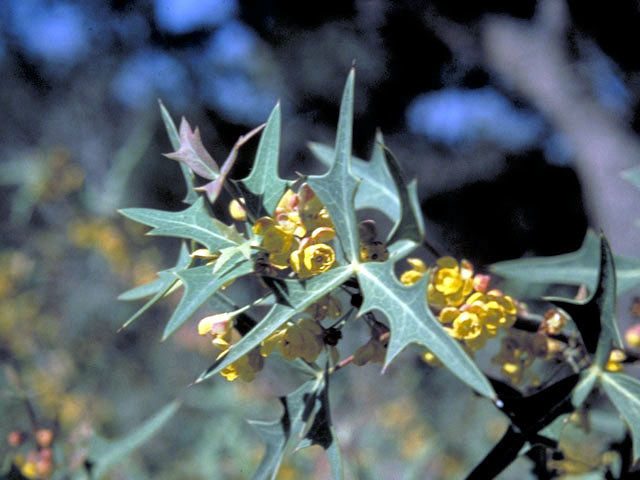Agarita (Mahonia trifoliolata)
Agarita (Mahonia trifoliolata)
Low stock: 1 left
Couldn't load pickup availability
Mahonia trifoliolata (Moric.) Fedde
Agarita, Agarito, Algerita, Laredo Mahonia, Laredo Oregon-grape, Trifoliate Barberry, Wild Currant
Berberidaceae (Barberry Family)
Synonym(s): Berberis trifoliolata, Berberis trifoliolata var. glauca, Mahonia trifoliolata var. glauca
USDA Symbol: MATR3
This 3-6 ft. evergreen shrub, can reach 10 ft. in favorable conditions. The rigid, spreading branches often form thickets. Gray-green to blue-gray, trifoliate, holly-like leaves are alternate, 2-4 inches long, divided into three leaflets which have 3-7 lobes ending in sharp spines. Wood bright yellow. Flowers numerous, yellow, up to 1/2 inch wide with 6 petals and 6 sepals, which are similar, forming a cup shape around the stamens and pistils. Flowers appearing in February and March, their fragrance often filling the air where they are plentiful. Fruit a red berry, edible appearing from May to July.
Plant Characteristics
Habit: Shrub
Leaf Retention: Evergreen
Leaf Complexity: Trifoliate
Breeding System: Flowers Bisexual
Fruit Type: Berry
Size Notes: Up to about 10 feet tall, often shorter.
Bloom Time: Feb , Mar , Apr
Distribution
USA: AZ , NM , TX
Native Distribution: Coastal s. TX through Trans-Pecos to s. AZ & n. Mex.
Native Habitat: Hills; open woods; rocky slopes & cliffs, thickets and open woods from coastal South Texas northwest to the Trans-Pecos. Well-drained loam, clay, caliche, limestone.
Growing Conditions
Water Use: LowLight Requirement: Sun , Part Shade
Soil Moisture: Dry , Moist
Soil Description: Rocky, limestone soil.
Conditions Comments: This evergreen shrub has rigid, spreading branches often forming thickets. Gray-green to blue-gray, trifoliate, holly-like foliage has needle-sharp tips. Clusters of fragrant, yellow flowers are followed by red berries from May to July. Songbirds eat the fruits, and quail and small mammals use the plant for cover. It is considered a good honey source.
Benefit
Use Wildlife: Songbirds eat fruits. Quail and small mammals use the plant for cover. Considered a good honey source.Use Food: The lustrous red fruit is a pea-sized berry that is used in making jelly and wine.
Use Other: Roots furnished a yellow dye used by early pioneers.
Fragrant Flowers: yes
Interesting Foliage: yes
Attracts: Birds
Deer Resistant: High
https://www.wildflower.org/plants/result.php?id_plant=MATR3
Image Information
Photographer: Flaigg, Norman G.State: TX
Accession date: 1988-10-21
Filename: PCD1323_IMG0027.JPG
Slide Index: B8 86-1729
Restrictions: Unrestricted
Collection: Wildflower Center Slide Library
Original Format: 35 MM
Orientation: Landscape
Shot: Flower(s)
Date Taken: 1986
NPIN Image Id: 2996


